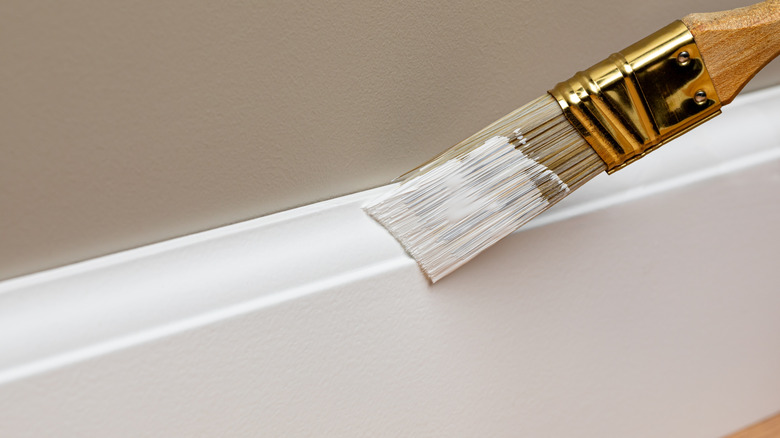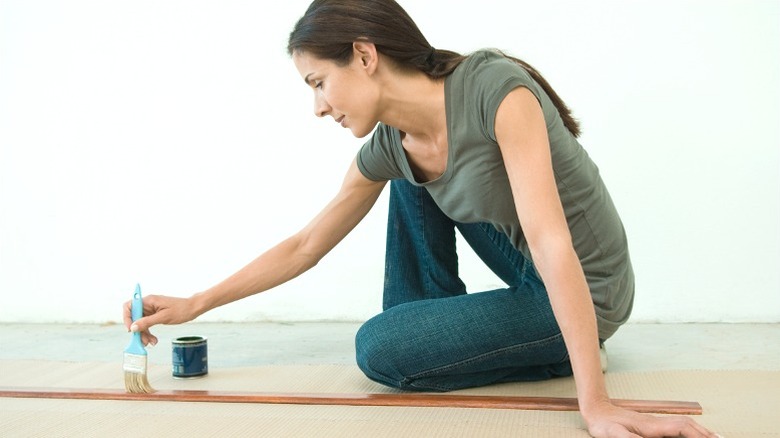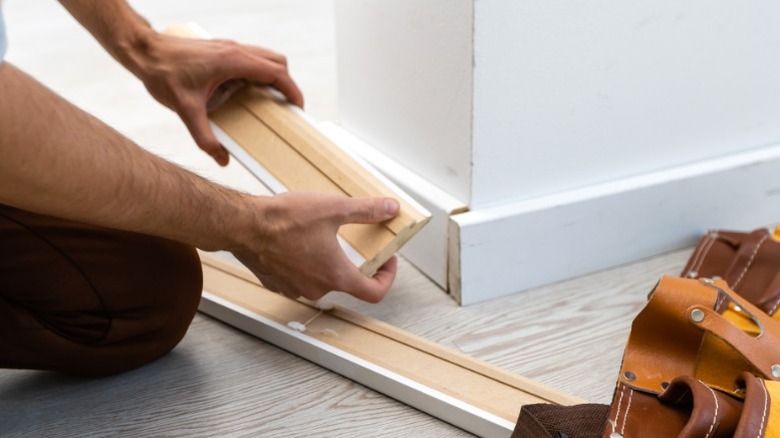The Painting Tip That Will Save You Time When Upgrading Baseboard Trim
Even though we love how it creates a clean, attractive finish following a remodel, it's safe to say most of us would rather watch paint dry than be the ones to put it on the wall. It isn't just that painting a room is messy and easy to mess up with one wrong move — the work involved is exhausting and only gets worse when you have to stop and work around various ceiling, window, and floor trim.
Finding efficiency when upgrading your baseboard trim can make a world of difference in the painting process and the end results. While there are a few ways to do that, much of it comes down to deciding whether you should paint your baseboards before or after installation. Opinions can vary, so we reached out to Van Sureja, owner and president of Liberty Painting, for an experienced professional's top tips for painting trim. According to him, the best choice is often obvious.
"Painting your new baseboards ahead of installation can save you time and hassle!" Sureja said in his exclusive interview with House Digest. As he discussed, finishing the job on sawhorses beats painting while the baseboards are in place for several reasons. "Pre-painting can be much less physically taxing (since you don't have to bend or sit on the floor for long periods). Pre-painting also means you don't have to worry about drips or mistakes on walls and floors," he explained. But the benefits don't stop there. As Sureja noted, there are only a few circumstances when you might want to try painting your trim after installation.
Pros and cons of painting baseboards before installing them
As one of the better hacks for painting baseboards like a pro, adding color before installation takes out much of the hassle while helping to limit imperfections. "Pre-painting baseboards makes it easier to apply paint evenly and produce a professional finish," Sureja said in his exclusive interview with House Digest. "Painting baseboard trim before installation is a great time-saver. You won't need to rigorously tape off walls or floors or worry about painting precisely around corners."
Despite the perks, painting your trim off the wall may not always be preferable, particularly if it's simply time to repaint your baseboards. "If you're not using new baseboard trim, it may be overly cumbersome to remove the existing trim for painting and then reinstall it," Sureja advised. He added that while the details are easy to handle ("Touch-ups after installation should be a breeze!"), they also take extra steps when you pre-paint. "You'll likely need to add at least one more coat after installation to fill nail holes and touch up any imperfections, so pre-painting may not be right for every person or project."
Expert tips to paint and install baseboard trim
It isn't enough to simply paint your baseboards before installing them. In his exclusive House Digest interview, Sejura explained that you can make the process easier at nearly every step of the upgrade process, even starting with your initial baseboard purchase. "Consider purchasing pre-primed baseboard trim," Sejura recommended, highlighting its value in saving time and money during preparation.
When you're ready to paint, your technique and attention to detail will determine the baseboard's looks and longevity. "Paint all sides of the trim, including the back, to protect it from water damage — especially in bathrooms," Sejura stated. "Hang baseboards for 360-degree painting or use sawhorses and rotate trim after each coat for an even, professional finish." After that, you're ready to put your trim on the wall. "Place your painted trim according to wall studs and secure with brad nails," he continued. "Fill holes and seal small gaps with caulk or putty and allow to dry. Prime and paint over sealed holes and imperfections with a brush to touch up your work."


